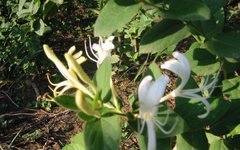Source: Zhangjiagang Traditional Chinese Medicine Hospital
In daily life,
we often come across many traditional Chinese medicinal herbs.
Can you recognize them all?
Jiangsu Provincial Administration of Traditional Chinese Medicine
has specially created
the “Encyclopedia of Chinese Medicine”
to help everyone understand the herbal medicines in our lives.
Please stay tuned.
▼▼▼
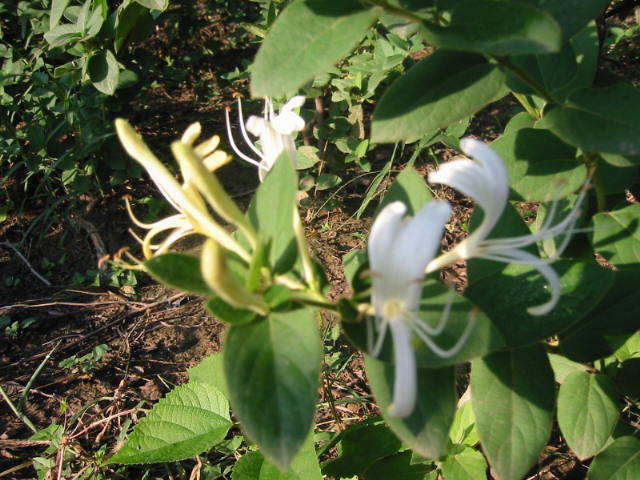
Source
Jin Yin Hua (Honeysuckle) is the dried flower buds or newly opened flowers of the plant Lonicera japonica Thunb. It is harvested in early summer before the flowers bloom and then dried.
Alias
Honeysuckle flower, silver flower, Erbao flower, double flower.
Origin
Mainly produced in Fengqiu County, Xinmi City, Puyang County, Xin’an County, Tangyin County, Minquan County, Xichuan County, and Yuzhou City in Henan Province, known as “Fengqiu Jin Yin Hua” or “Mi Yin Hua”. Significant production also occurs in Pingyi, Shandong, and Julu, Hebei. Most regions in the country produce it.
Harvesting and Processing
Jin Yin Hua is a perennial semi-evergreen climbing shrub with creeping stems. The young branches are slender and hollow, with a brown to reddish-brown color. The ovate leaves are opposite, and both branches and leaves are densely covered with soft hairs and glandular hairs. It flowers in summer, with leaf-like bracts, and the tubular flowers have a faint fragrance, covered with soft hairs and glandular hairs. The stamens and style extend beyond the corolla, and the flowers grow in pairs in the leaf axils. The flower color starts as white and gradually turns yellow, hence the name Jin Yin Hua.
The flower buds are rod-shaped, thicker at the top and tapering at the bottom, slightly curved. The surface is yellow-white or green-white, darkening with prolonged storage, and densely covered with short soft hairs. The calyx is small and green, with five lobes at the tip, and the lobes are hairy. The open flowers have a tubular corolla, with the tip being bilabiate, the upper lip having four lobes, and the lower lip not lobed. There are five yellow stamens attached to the wall of the tube; the pistil is single, and the ovary is hairless. It has a clear fragrance and a mild, slightly bitter taste. The best quality is characterized by unopened flower buds that are yellow-white or green-white, without impurities from branches and leaves.
Discussion: Differences Between Jin Yin Hua and Shan Yin Hua
Historically, Jin Yin Hua has always been a multi-source variety. From the 1977 edition to the 2000 edition, the Chinese Pharmacopoeia included Jin Yin Hua from multiple sources. In the 2005 edition, due to various complex reasons, the gray-haired honeysuckle, red-gland honeysuckle, and South China honeysuckle (also known as Shan Yin Hua) were separated and named “Shan Yin Hua”.
1. Different Sources
Jin Yin Hua is the dried flower buds or newly opened flowers of the plant Lonicera japonica.
Shan Yin Hua is the dried flower buds or newly opened flowers of the gray-haired honeysuckle, red-gland honeysuckle, yellow-brown-haired honeysuckle, or South China honeysuckle.
2. Different Characteristics
Jin Yin Hua is rod-shaped, thicker at the top and tapering at the bottom, measuring 2-3 cm in length, with a diameter of 3 mm at the top and 1.5 mm at the bottom, with a yellow-white or green-white surface, densely covered with short soft hairs. Occasionally, leaf-like bracts are seen, the calyx is green, with five lobes at the tip, and the lobes are hairy, about 2 mm long. The open flower has a tubular corolla, with the tip being bilabiate, five yellow stamens attached to the wall of the tube; the pistil is single, and the ovary is hairless, with a clear fragrance and a mild, slightly bitter taste.
Shan Yin Hua:
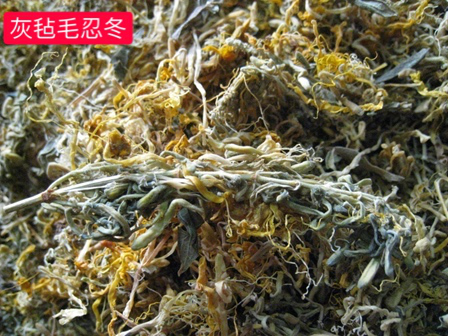
Gray-haired honeysuckle: rod-shaped and slightly curved, measuring 3-4.5 cm in length, with a diameter of 2 mm at the top and 1 mm at the bottom, with a surface color ranging from green-brown to yellow-white. The flower stalks are clustered. The open flower has lobes that do not reach half the length, slightly hard in texture, and somewhat elastic when pinched, with a clear fragrance and a slightly bitter-sweet taste.
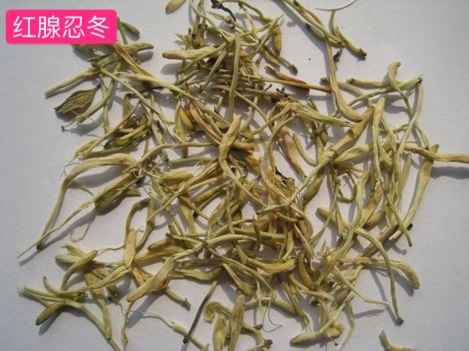
Red-gland honeysuckle: elongated and often exceeding 4 cm in length, but the middle diameter generally does not exceed 1 mm, and the upper diameter does not exceed 2 mm. The surface is yellow-white to yellow-brown, hairless or sparsely hairy. The calyx tube surface is smooth, nearly hairless, with five lobes at the tip, and the lobes are triangular and hairy. The open flower has a reversed lower lip, and the flower column is hairless. The leaf petioles and the lower surface of the leaves are covered with short soft hairs, while the upper surface is hairless.
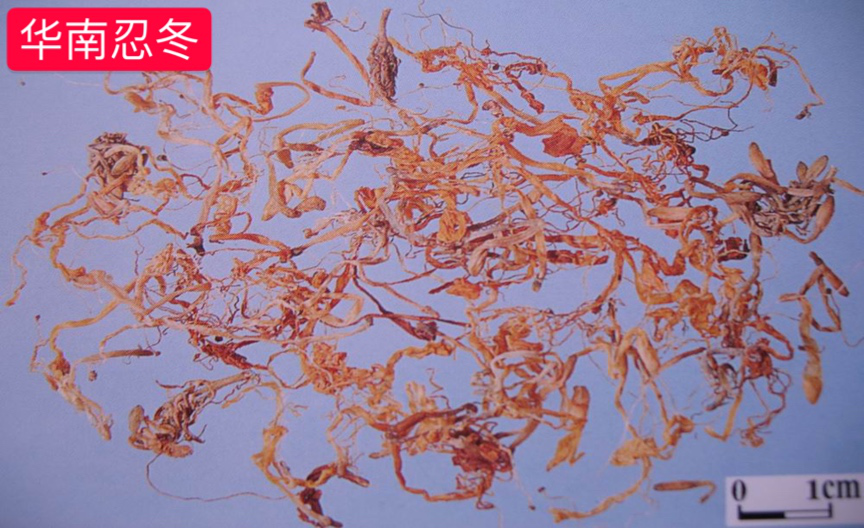
South China honeysuckle: measuring 1.6-3.5 cm in length, with a diameter of 0.5-2 mm, with the calyx tube and corolla densely covered with gray-white hairs, and the ovary is hairy.
Yellow-brown-haired honeysuckle: measuring 1-3.4 cm in length, with a diameter of 1.5-2 mm. The surface of the corolla is light yellow-brown or yellow-brown, densely covered with yellow fluff.
Jin Yin Hua has large leaf-like bracts, and the calyx tube is hairless, making it easier to distinguish from Shan Yin Hua.
3. Differences in Aroma, Size, Color, and Texture
1) Aroma: Jin Yin Hua has a more fragrant aroma, while Shan Yin Hua has a more subdued scent.
2) Size: Jin Yin Hua is shorter and sturdier, with fuller flower buds.
3) Color: Jin Yin Hua is mostly green-white to yellow-white, while Shan Yin Hua is darker in color.
4) Texture: Jin Yin Hua has a slightly soft texture, with a dense, fluffy surface.
4. Differences in Composition and Content
Jin Yin Hua contains chlorogenic acid, and the 2015 edition of the Pharmacopoeia stipulates that it must contain no less than 1.5% chlorogenic acid. Jin Yin Hua also contains luteolin glycoside, with the 2015 edition of the Pharmacopoeia stipulating that it must contain no less than 0.050% luteolin glycoside.
Shan Yin Hua contains chlorogenic acid, with the 2015 edition of the Pharmacopoeia stipulating that it must contain no less than 2.0% chlorogenic acid.
In southern regions such as Hunan, Guizhou, Chongqing, and Sichuan, the mainstream variety is gray-haired honeysuckle, commonly referred to as “Southern Jin Yin Hua” or Shan Yin Hua. The main production areas in Hunan are Longhui and Xupu, with Longhui County having the largest cultivation area and yield. In 2001, it was designated as the “Hometown of Jin Yin Hua” by the National Forestry Administration. The main variety is gray-haired honeysuckle, followed by red-gland honeysuckle, with an annual production peak exceeding 10,000 tons, accounting for over 50% of the total national production of Jin Yin Hua. Reports indicate that the chlorogenic acid content in Hunan-produced Shan Yin Hua reaches 4.24-6.9%, higher than that of Shandong (1.5-3.8%) and Henan (1.5-3.0%). Modern pharmacology has proven that chlorogenic acid has antibacterial, anti-inflammatory, detoxifying, and choleretic effects, playing a significant role during the SARS outbreak in 2003.
In my personal opinion, the debate over the authenticity of Jin Yin Hua and Shan Yin Hua is complex and involves regional competition. We should rely on clinical practice for rational discussion and exploration.
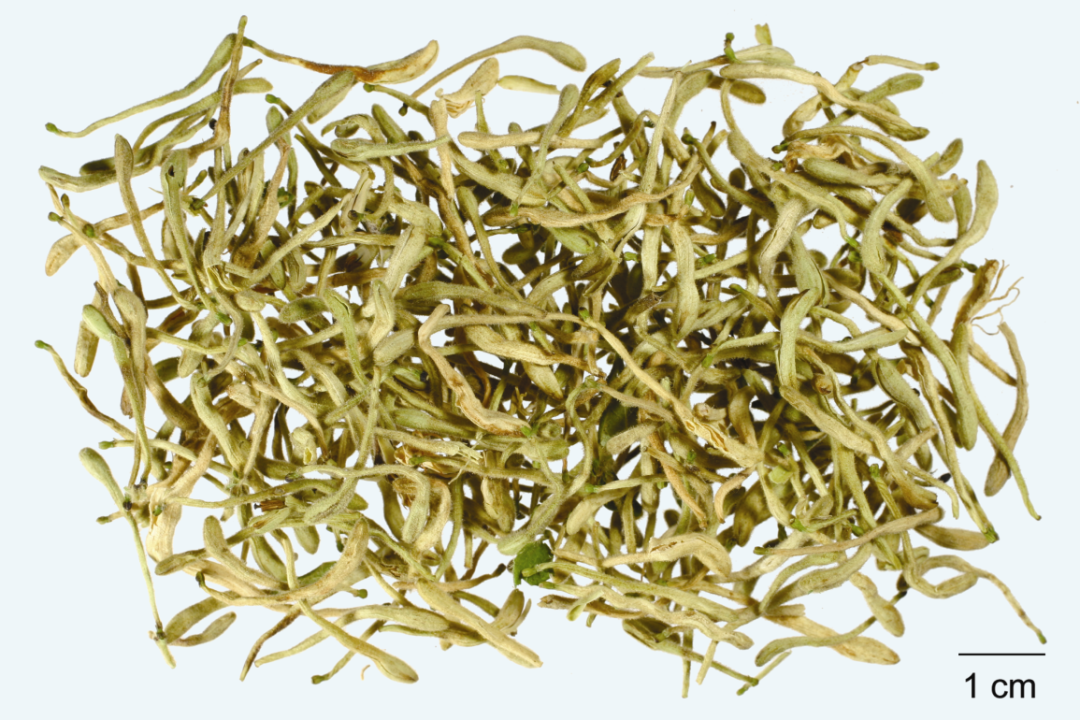
Properties and Channels
Sweet, cold. Enters the Lung, Heart, and Stomach meridians.
Functions
Clears heat and detoxifies, disperses wind-heat.
Indications
The “Dian Nan Ben Cao” states: “Clears heat, resolves various sores, and treats carbuncles and boils.” Jin Yin Hua’s heat-clearing and detoxifying effects are recorded; “Sheng Cao Yao Xing Bei Yao” mentions “stops dysentery… removes blood heat from the skin…”; “Ben Cao Bei Yao” states “nourishes blood and stops thirst,” adding new therapeutic effects; “Chongqing Tang Sui Bi” mentions “clears wind-heat dampness, resolves epidemic toxins, calms liver and gallbladder wind, treats convulsions and epilepsy.” This herb has a long history of use, first recorded in the Tang Dynasty’s “Newly Revised Materia Medica,” especially popular during the Ming and Qing Dynasties, closely related to the rise of the warm disease school.
1. Carbuncles and Sores
This herb is sweet and cold, clears heat and detoxifies, disperses carbuncles and swelling, making it essential for treating all internal and external carbuncles. It is often combined with herbs like Di Ding Cao, Pu Gong Ying, Yu Xing Cao, and Tu Fu Ling for heat-clearing and detoxifying effects, along with Huang Qi and Dang Gui for tonifying effects. Using Lian Qiao and Ban Lan Gen to decoct Jin Yin Hua soup can treat mumps; simultaneously, boiling Jin Yin Hua, Chrysanthemum, Platycodon, and Licorice in water for 10 minutes, then cooling, can be consumed as a beverage to treat pharyngitis and tonsillitis; it can also be used for sore throat, children’s heat sores, and prickly heat.
2. External Wind-Heat and Initial Stage of Warm Disease
This herb is sweet and cold, aromatic and dispersing, effectively dispersing lung heat evil and reaching the surface. It is often used with Lian Qiao, Bo He, and Niu Bang Zi to treat external wind-heat. Clinically, this herb can also be used primarily to treat cough caused by pneumonia or bronchitis. It effectively clears heart and stomach heat toxins, with the ability to disperse heat from the Ying level. If the warm disease heat enters the Qi level, at the initial stage of warm disease, with fever, headache, sore throat, and thirst, it can be combined with Shi Gao and Zhi Mu; if heat enters the Ying and blood levels, with high fever and delirium, red tongue and confusion, it can be combined with Shui Niu Jiao, Sheng Di, Xuan Shen, and Huang Lian to enhance efficacy.
3. Heat-Toxin Dysentery
This herb is sweet and cold, with heat-clearing, detoxifying, and cooling blood effects, thus commonly used to treat heat-toxin dysentery with purulent blood. It can be taken alone as a concentrated decoction; it can also be combined with Huang Qin, Huang Lian, and Bai Tou Weng to enhance the effect of stopping dysentery. Usage tips: Jin Yin Hua combined with Jing Jie Sui, soaked in boiling water for 3 minutes, is very effective for treating wind-cold colds. Points to note: First, after catching a cold, taking it at the first sign of symptoms is most effective. If wind-cold transforms into heat, causing symptoms like sore throat, this formula is also effective. Second, the soaking time in boiling water does not need to be too long; 3 minutes is sufficient. Third, Jing Jie Sui is more effective than Jing Jie.
Note: The stem and branches of the honeysuckle are known as Jin Yin Teng, with aliases such as Jin Yin Teng, Yin Teng, Er Se Hua Teng, Er Bao Teng, You Zhuan Teng, Zi Feng Teng, and Yuan Yang Teng. It can clear heat and detoxify, disperse wind-heat, and relieve pain. After boiling, it has certain therapeutic effects on children’s eczema and skin itching.
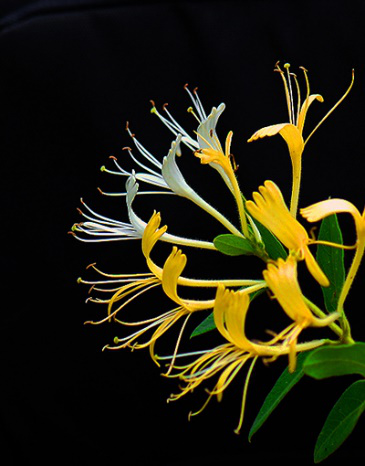
Processing Standards
1. Jin Yin Hua:Take the raw herb, remove residual stems, leaves, and impurities, and sift out ash.
2. Stir-fried Jin Yin Hua:
Take clean Jin Yin Hua, place it in a hot pan, and stir-fry over low heat until it turns yellow, then take it out and spread it out to cool. This is often used in the mid-stage of warm disease.
3. Charred Jin Yin Hua:
Take cleaned Jin Yin Hua, place it in a pan, and stir-fry over medium heat until the surface turns dark brown, spray a little water to extinguish any flames, dry it out, and take it out to cool thoroughly.
Raw Jin Yin Hua disperses wind-heat and clears internal heat strongly, with a clear fragrance, used for external wind-heat warm diseases, lung heat cough, etc. Charred Jin Yin Hua has a sweet and bitter taste, with its cold nature weakened and leaning towards flat, but it increases the ability to disperse and can clear heat while also dispersing heat evil from the Qi level, thus often used in the mid-stage of warm disease. The subtlety of this application can be deeply appreciated in clinical practice. After charring, the cold nature is slightly weakened, and it has astringent properties, which can stop bleeding, suitable for heat-toxin dysentery, and can also be used for vomiting blood and nosebleeds. A key point here is that for charred herbs, a general principle is “to preserve the properties of the charred herb”; it must not be overdone, as if the herb turns to ash, its clinical efficacy is completely lost. This is also a critical issue we should focus on during quality control. In practical work, I have also found instances where charred Jin Yin Hua was overdone, crumbling to powder with a light touch, smelling only of charred ash, and this type must not be used and should be immediately returned as unqualified.
Jin Yin Hua prepared as a syrup is often used for summer heat and thirst.
Dosage and Administration
Decoction, 6-15 g. Additionally, for treating sores and abscesses, a higher dosage of 60-90 g is recommended.
Precautions
Use with caution in cases of spleen and stomach deficiency-cold and sores that are yin in nature.
Selected Formulas
1. For Taiyin wind-warmth, initial stage of warm disease, but with heat not intolerant to cold and thirst: Lian Qiao 50 g, Jin Yin Hua 50 g, Ku Ju Gen 30 g, Bo He 30 g, Zhu Ye 20 pieces, Sheng Gan Cao 25 g, Jing Jie Sui 20 g, Dan Dou Chi 25 g, Niu Bang Zi 30 g. Grind into a powder, take 30 g each time, decoct with fresh reed root soup. (“Wen Bing Tiao Bian” Yin Qiao San)
2. For dysentery: Jin Yin Hua (roasted in a copper pot, dried to preserve its properties) 25 g. For red dysentery, take with white honey water; for white dysentery, take with sugar water. (“Hui Zhi Tang Experience Formula”)
3. For heat dysuria: Jin Yin Hua, Hai Jin Sha Teng, Tian Hu Su, Jin Ying Zi root, Bai Mao Gen each 50 g. Decoction, one dose per day, for five to seven days as a course of treatment. (“Jiangxi Herbal Medicine”)
4. For biliary tract infections, wound infections: Jin Yin Hua 50 g, Lian Qiao, Da Qing Gen, Huang Qin, and Wild Chrysanthemum each 25 g. Decoction, one dose per day. (“Jiangxi Herbal Medicine”)
5. For severe pain from sores and abscesses, with discoloration to purple-black: Jin Yin Hua with branches and leaves (chopped) 100 g, Huang Qi 200 g, Gan Cao 50 g. Finely chop, add one liter of wine, seal in a jar, boil in water for two to three hours, take out, strain, and take it all at once. (“Huo Fa Ji Yao” Hui Chuang Jin Yin Hua San)
6. For all swellings and toxins, regardless of whether they have ruptured or not, or initial onset with fever, and for carbuncles and throat phlegm: Jin Yin Hua (with branches and leaves) half a bowl of natural juice, decoct to eight parts, take it, and apply the residue externally, dispelling toxins and harmonizing blood, with unique efficacy. (“Ji Shan Tang Experience Formula”)
7. For initial onset of carbuncles and abscesses: Jin Yin Hua 250 g, water ten bowls, decoct to two bowls, add Dang Gui 100 g, and decoct to one bowl, take it all at once. (“Dong Tian Ao Zhi” Gui Hua Tang)
8. For all internal and external carbuncles and swellings: Jin Yin Hua 200 g, Gan Cao 150 g. Decoction and take it all at once; for those who can drink, use wine for decoction. (“Yi Xue Xin Wu” Ren Dong Tang)
9. For large intestine abscess, cannot be pressed, right foot bent and not extended: Jin Yin Hua 150 g, Dang Gui 100 g, Di Yu 50 g, Mai Dong 50 g, Xuan Shen 50 g, Sheng Gan Cao 15 g, Yi Ren 25 g, Huang Qin 10 g. Decoction. (“Dong Tian Ao Zhi” Qing Chang Yin)
END

Scan the QR codeto follow “Jiangsu Traditional Chinese Medicine” immediately

